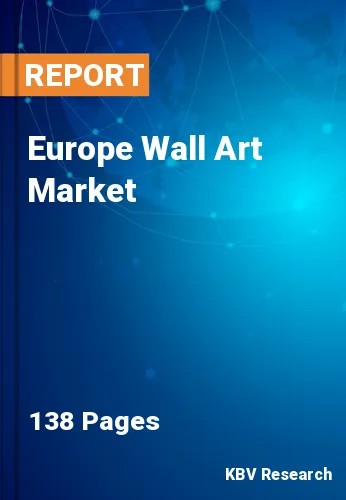The Europe Wall Art Market would witness market growth of 5.2% CAGR during the forecast period (2023-2030). In the year 2020, the Europe market's volume surged to 399.6 million units, showcasing a growth of 6.1% (2019-2022).
One of the most groundbreaking developments in recent years is the rise of digital art and non-fungible tokens (NFTs). Digital art, often created using digital media, software, and computers, has gained prominence. NFTs, which represent ownership of a unique digital asset using blockchain technology, have disrupted the traditional art sector by offering artists new avenues for distribution and monetization. The demand for personalized and custom wall art has surged. Customers seek unique pieces that reflect their individuality, and artists are responding by offering commissioned works that align with the client's vision and interior decor.
NFTs represent ownership of a unique digital asset, often a piece of digital art, and are stored on a blockchain. This technology has created a new way for digital artists to sell their work, with some pieces selling for millions of dollars. NFT art has opened the door to new possibilities for artists to monetize their creations. Digital art has become increasingly popular. Artists are creating interactive and dynamic digital pieces that can be displayed on screens or even integrated into augmented reality (AR) experiences. These artworks can change over time, respond to viewer interactions, or adapt to environmental conditions.
Europe is a popular tourist destination, and hotels, restaurants, and other hospitality businesses often invest in wall art to enhance their decor and create unique experiences for guests. This creates a significant demand for art in various forms. Tourism represents an important part of the EU's overall economy. According to the European Commission data, in 2019, it represented nearly 10% of the EU GDP. Moreover, according to Eurostat, in 2021, Spain was the most common tourism destination in the EU for international tourists. The second most popular EU destination for international tourists in 2021 was Italy, followed by Croatia, Greece, and France. Therefore, the demand for wall art in Europe is driven by a combination of historical, cultural, economic, and societal factors, making it a thriving and diverse market for artists and art enthusiasts.
The Germany market dominated the Europe Wall Art Market, by Country in 2022, and would continue to be a dominant market till 2030; thereby, achieving a market value of $4,907.5 Million by 2030. The UK market is experiencing a CAGR of 4.3% during (2023 - 2030). Additionally, The France market would exhibit a CAGR of 5.9% during (2023 - 2030).
Based on Type, the market is segmented into Wallpapers/Stickers/Wall Coverings, Hangings, Frameworks (Clock, Wood, Metal, Cotton Framework, Etc.), Décor Shelves, and Others. Based on Sales Channel, the market is segmented into Specialty Stores, Hypermarkets and Supermarkets, Online, and Others. Based on Application, the market is segmented into Residential, and Commercial. Based on countries, the market is segmented into Germany, UK, France, Russia, Spain, Italy, and Rest of Europe.
Free Valuable Insights: The Global Wall Art Market will Hit $78.1 Billion by 2030, at a CAGR of 5.4%
The market research report covers the analysis of key stake holders of the market. Key companies profiled in the report include Saatchi Art, Artfinder (Art Discovery Ltd), Minted LLC, Artspace LLC, Art.sy, Inc., Art.com (Trends International LLC), Zatista LLC, The Tallenge Store, Artisera, and Seven wall Arts Inc.
By Type (Volume, Million Units, USD Million, 2019-2030)
By Sales Channel (Volume, Million Units, USD Million, 2019-2030)
By Application (Volume, Million Units, USD Million, 2019-2030)
By Country (Volume, Million Units, USD Million, 2019-2030)
Our team of dedicated experts can provide you with attractive expansion opportunities for your business.

